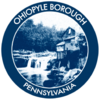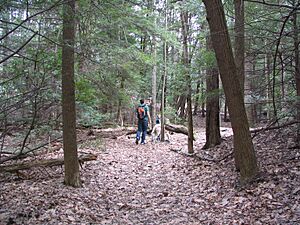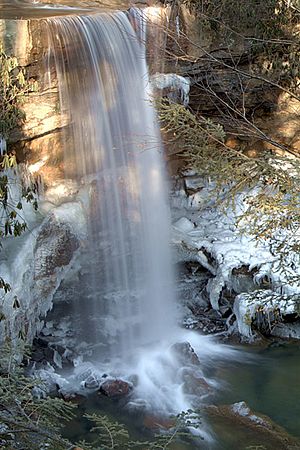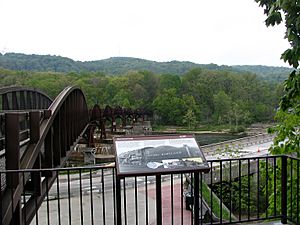Ohiopyle, Pennsylvania facts for kids
Quick facts for kids
Ohiopyle, Pennsylvania
|
||
|---|---|---|
|
Borough
|
||
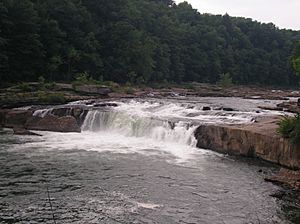
Ohiopyle Falls on the Youghiogheny River
|
||
|
||
| Etymology: Lenape ahi opihəle, "it turns very white" | ||

Location in Fayette County, Pennsylvania
|
||
| Country | United States | |
| State | Pennsylvania | |
| County | Fayette | |
| Established | 1868 | |
| Area | ||
| • Total | 0.50 sq mi (1.29 km2) | |
| • Land | 0.42 sq mi (1.08 km2) | |
| • Water | 0.08 sq mi (0.21 km2) | |
| Population
(2020)
|
||
| • Total | 37 | |
| • Density | 88.52/sq mi (34.18/km2) | |
| Time zone | UTC-5 (EST) | |
| • Summer (DST) | UTC-4 (EDT) | |
| Area code(s) | 724 | |
Ohiopyle is a small town, called a borough, in Fayette County, Pennsylvania, United States. In 2020, only 38 people lived there all year. Even though it's tiny, Ohiopyle often gets very busy with tourists on weekends. People come for the fun outdoor activities at the nearby Ohiopyle State Park. They also enjoy the Great Allegheny Passage bicycle trail. This trail connects to another path, forming a long 335-mile trail from Pittsburgh, Pennsylvania, all the way to Washington, D.C. Students in Ohiopyle attend schools in the Uniontown Area School District.
Contents
History of Ohiopyle
Early People in the Ohiopyle Area
The first known group of people to live in the Ohiopyle area were the Monongahela. They were a group of Mound Builders, Native Americans who built large earth mounds. These Native Americans left the area around the time European settlers started arriving in North America.
As more Europeans settled the east coast, Native American tribes living closer to the Atlantic Ocean moved or were forced to go west. Different tribes lived in the Ohiopyle area before they were moved after the French and Indian War. The name "Ohiopyle" itself comes from the Lenape phrase ahi opihəle. This means 'it turns very white', which describes the foamy waterfalls in the area.
The French and Indian War in Ohiopyle
In the 1700s, two powerful groups, New France (French colonists) and the British Thirteen Colonies, fought for control of important trading routes. These routes were in the Ohio River Valley, which was then the western edge of America. The French were the first to explore the upper parts of the Ohio and Mississippi River valleys. They built several forts in what is now western Pennsylvania. One of these was Fort Duquesne in present-day Pittsburgh.
A young George Washington was sent by the governor of Virginia to try and take back this important fort. He traveled through the Ohiopyle area twice. Washington hoped to use the Youghiogheny River to reach Fort Duquesne quickly. However, the waterfalls in Ohiopyle stopped him from using the river.
Washington and his troops continued towards Pittsburgh. They met and defeated a small group of French soldiers in the Battle of Jumonville Glen. One French soldier escaped and warned Fort Duquesne. Washington quickly built a small fort, Fort Necessity, to get ready for a French attack. Fort Necessity is just southwest of Ohiopyle State Park.
At the Battle of the Great Meadows at Fort Necessity, Washington's forces were defeated by the French and their Native American allies. These battles are seen as the start of the French and Indian War. This war later spread to Europe and became known as the Seven Years' War. The loss at Fort Necessity was the only time Washington ever surrendered in battle. The British eventually won the French and Indian War, and the French had to leave western Pennsylvania.
Who Owned the Land? Pennsylvania or Virginia?
In 1763, King George III said the Ohiopyle area was an Indian reserve. He told all European settlers to leave. But the settlers did not want to go. So, in 1768, King George bought the land from the Iroquois tribe.
However, both Pennsylvania and Virginia claimed this land. This argument over the territory lasted through the American Revolution. It was finally settled in 1784.
The Whiskey Rebellion
After the American Revolution, the new United States government faced a big challenge called the Whiskey Rebellion. People in western Pennsylvania, especially near Washington, Pennsylvania, were unhappy about a new tax. This tax was on liquor and other distilled drinks. United States Secretary of the Treasury Alexander Hamilton suggested this tax. Congress passed it, and President Washington signed it into law in 1791.
Tensions grew over the next three years. By 1794, there was a serious uprising in the area. President George Washington sent 13,000 soldiers, led by himself, to stop the uprising. They marched through the Ohiopyle area to find the rebels. The soldiers arrested about twenty people, showing that the new Federal government had power.
Two of the arrested men were found guilty of serious crimes and sentenced to death. However, Washington decided to forgive them. He said one was "simple" and the other "insane." The government's strong response to the Whiskey Rebellion set an important example. It showed that if U.S. citizens wanted to change a law, they had to do it peacefully through the constitution. If they threatened peace, the government would use force to keep order.
Lumbering and Tourism in Ohiopyle
The first settlers in the Ohiopyle area were farmers, trappers, and hunters. The population grew after the National Road was built in 1811. This road passed near Ohiopyle, making it easier to reach and connect to markets in the east.
Logging, or lumbering, became the main industry. Smaller businesses included making barrels (cooperage), tanning leather, and coal mining.
The building of the Baltimore and Ohio Railroad and the Western Maryland Railroad really sped up logging in Ohiopyle. Both railroads had stations in the town. Smaller narrow gauge railroads were built into the mountains. These smaller trains efficiently carried lumber to the sawmills and train stations in Ohiopyle.
The railroads also brought tourists to Ohiopyle. A round trip from Pittsburgh to Ohiopyle cost only one dollar. Tourists loved coming to see the waterfalls and stay at the resorts that quickly appeared along the Youghiogheny River. These resorts had fun things like boardwalks, dance halls, bowling alleys, and tennis courts.
However, when cars became popular, the resorts in Ohiopyle closed down. The buildings were taken apart, and the forests were allowed to grow back.
In 1963, Ohiopyle started a new chapter of tourism. A company called Wilderness Voyageurs began offering commercial whitewater rafting trips on the Youghiogheny River. This was the first company to do this east of the Mississippi River. In 1963, about 400 people tried the rapids. By 2007, over 100,000 people came to "shoot the rapids" in rafts, kayaks, and canoes. Ohiopyle is also close to Fallingwater, a famous house designed by Frank Lloyd Wright in 1936. This nearby attraction also brings many visitors to the town.
Geography and Climate
Ohiopyle is located at 39°52′5″N 79°29′35″W / 39.86806°N 79.49306°W.
The United States Census Bureau says the town covers about 0.5 square miles (1.29 square kilometers). Most of this is land, but about 0.1 square miles (0.21 square kilometers) is water. The town is completely surrounded by Ohiopyle State Park.
The Youghiogheny River flows right through the town.
Ohiopyle's Climate
The weather in Ohiopyle doesn't have huge differences between its highest and lowest temperatures. It also gets enough rain all year long. According to the Köppen Climate Classification system, Ohiopyle has a marine west coast climate. This means it has mild summers and cool, but not freezing, winters.
| Climate data for Ohiopyle, Pennsylvania | |||||||||||||
|---|---|---|---|---|---|---|---|---|---|---|---|---|---|
| Month | Jan | Feb | Mar | Apr | May | Jun | Jul | Aug | Sep | Oct | Nov | Dec | Year |
| Mean daily maximum °C (°F) | 1 (34) |
3 (38) |
9 (48) |
16 (61) |
21 (69) |
24 (75) |
26 (78) |
25 (77) |
21 (70) |
16 (60) |
10 (50) |
3 (38) |
14 (58) |
| Mean daily minimum °C (°F) | −7 (19) |
−7 (20) |
−3 (27) |
3 (37) |
8 (46) |
13 (55) |
15 (59) |
14 (58) |
11 (51) |
4 (40) |
0 (32) |
−5 (23) |
4 (39) |
| Average precipitation mm (inches) | 110 (4.4) |
97 (3.8) |
120 (4.6) |
120 (4.9) |
140 (5.4) |
130 (5) |
140 (5.5) |
110 (4.3) |
110 (4.4) |
94 (3.7) |
110 (4.3) |
110 (4.2) |
1,380 (54.3) |
| Source: Weatherbase | |||||||||||||
Population Changes
| Historical population | |||
|---|---|---|---|
| Census | Pop. | %± | |
| 1900 | 423 | — | |
| 1910 | 535 | 26.5% | |
| 1920 | 499 | −6.7% | |
| 1930 | 425 | −14.8% | |
| 1940 | 420 | −1.2% | |
| 1950 | 345 | −17.9% | |
| 1960 | 287 | −16.8% | |
| 1970 | 140 | −51.2% | |
| 1980 | 124 | −11.4% | |
| 1990 | 81 | −34.7% | |
| 2000 | 77 | −4.9% | |
| 2010 | 59 | −23.4% | |
| 2020 | 38 | −35.6% | |
| 2021 (est.) | 37 | −37.3% | |
| Sources: | |||
In the year 2000, there were 77 people living in Ohiopyle. These people lived in 34 households, with 21 of them being families. Everyone living in the borough was White.
About a quarter of the people (24.7%) were under 18 years old. The median age was 38 years old. This means half the people were younger than 38, and half were older.
See also
 In Spanish: Ohiopyle para niños
In Spanish: Ohiopyle para niños


